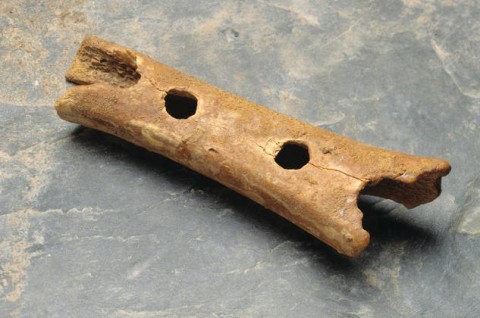Several years ago, we brought you a transcription and a couple of audio interpretations of the oldest known song in the world, discovered in the ancient Syrian city of Ugarit and dating back to the 14th century B.C.E.. Likely performed on an instrument resembling an ancient lyre, the so-called “Hurrian Cult Song” or “Hurrian Hymn No. 6” sounds otherworldly to our ears, although modern-day musicologists can only guess at the song’s tempo and rhythm.
When we reach even further back in time, long before the advent of systems of writing, we are completely at a loss as to the forms of music prehistoric humans might have preferred. But we do know that music was likely a part of their everyday lives, as it is ours, and we have some sound evidence for the kinds of instruments they played. In 2008, archeologists discovered fragments of flutes carved from vulture and mammoth bones at a Stone Age cave site in southern Germany called Hohle Fels. These instruments date back 42,000 to 43,000 years and may supplant earlier findings of flutes at a nearby site dating back 35,000 years.
Image via the The Archaeology News Network
The flutes are meticulously crafted, reports National Geographic, particularly the mammoth bone flute, which would have been “especially challenging to make.” At the time of their discovery, researchers speculated that the flutes “may have been one of the cultural accomplishments that gave the first European modern-human (Homo sapiens) settlers an advantage over their now extinct Neanderthal-human (Homo neanderthalensis) cousins.” But as with so much of our knowledge about Neanderthals, including new evidence of interbreeding with Homo sapiens, these conclusions may have to be revised.
It is perhaps possible that the much-underestimated Neanderthals made their own flutes. Or so a 1995 discovery of a flute made from a cave bear femur might suggest. Found by archeologist Ivan Turk in a Neanderthal campsite at Divje Babe in northwestern Slovenia, this instrument (above) is estimated to be over 43,000 years old and perhaps as much as 80,000 years old. According to musicologist Bob Fink, the flute’s four finger holes match four notes of a diatonic (Do, Re, Mi…) scale. “Unless we deny it is a flute at all,” Fink argues, the notes of the flute “are inescapably diatonic and will sound like a near-perfect fit within ANY kind of standard diatonic scale, modern or antique.” To demonstrate the point, the curator of the Slovenian National Museum had a clay replica of the flute made. You can hear it played at the top of the post by Slovenian musician Ljuben Dimkaroski.
The prehistoric instrument does indeed produce the whole and half tones of the diatonic scale, so completely, in fact, that Dimkaroski is able to play fragments of several compositions by Beethoven, Verdi, Ravel, Dvořák, and others, as well as some free improvisations “mocking animal voices.” The video’s YouTube page explains his choice of music as “a potpourri of fragments from compositions of various authors,” selected “to show the capabilities of the instrument, tonal range, staccato, legato, glissando….” (Dimkaroski claims to have figured out how to play the instrument in a dream.) Although archeologists have hotly disputed whether or not the flute is actually the work of Neanderthals, as Turk suggested, should it be so, the finding would contradict claims that the close human relatives “left no firm evidence of having been musical.” But whatever its origin, it seems certainly to be a hominid artifact—not the work of predators—and a key to unlocking the prehistory of musical expression.
Note: An earlier version of this post appeared on our site in 2015.
Related Content:
Hear the Oldest Song in the World: A Sumerian Hymn Written 3,400 Years Ago
What Ancient Greek Music Sounded Like: Hear a Reconstruction That is ‘100% Accurate’
Josh Jones is a writer and musician based in Durham, NC. Follow him at @jdmagness









